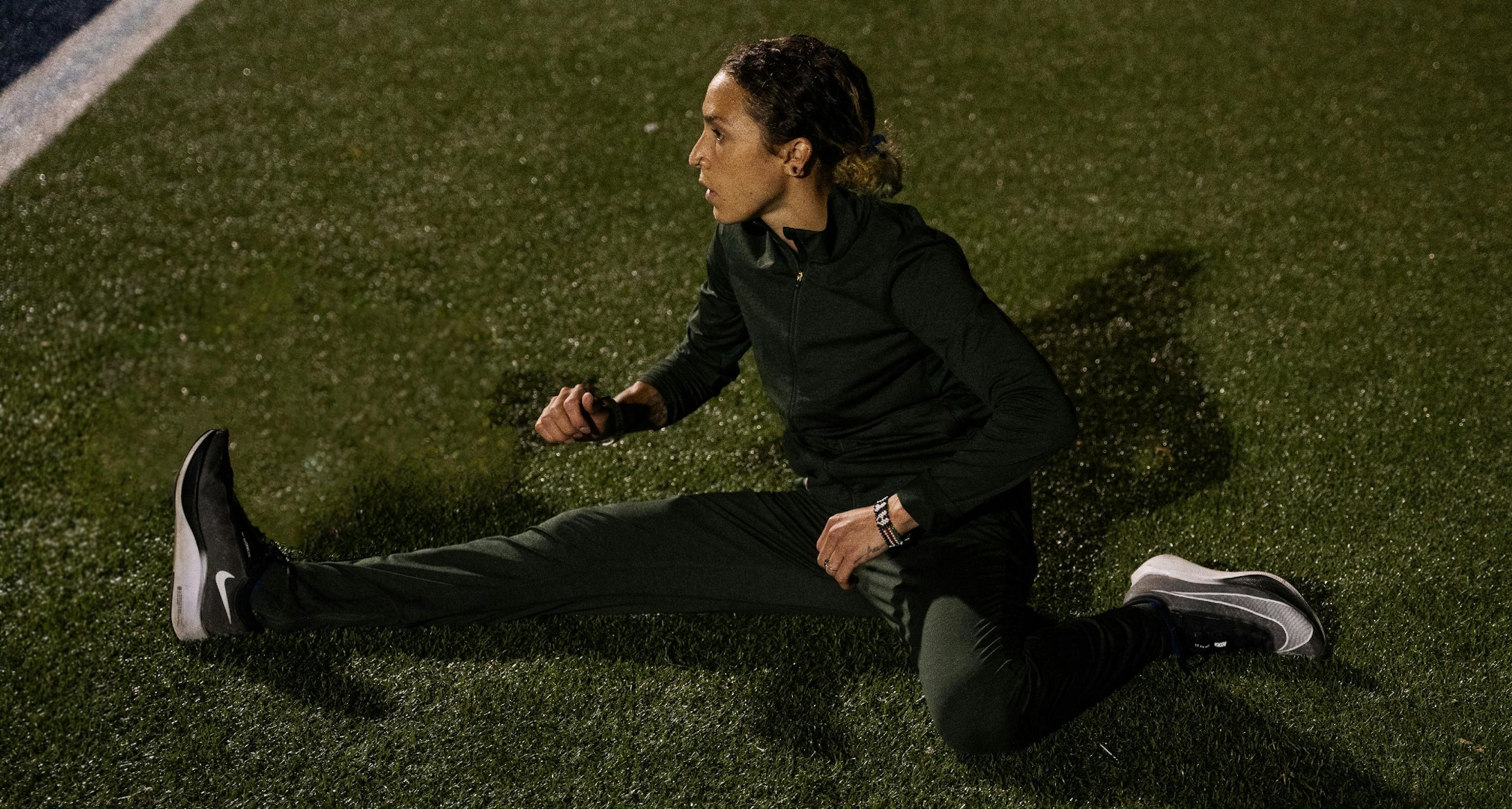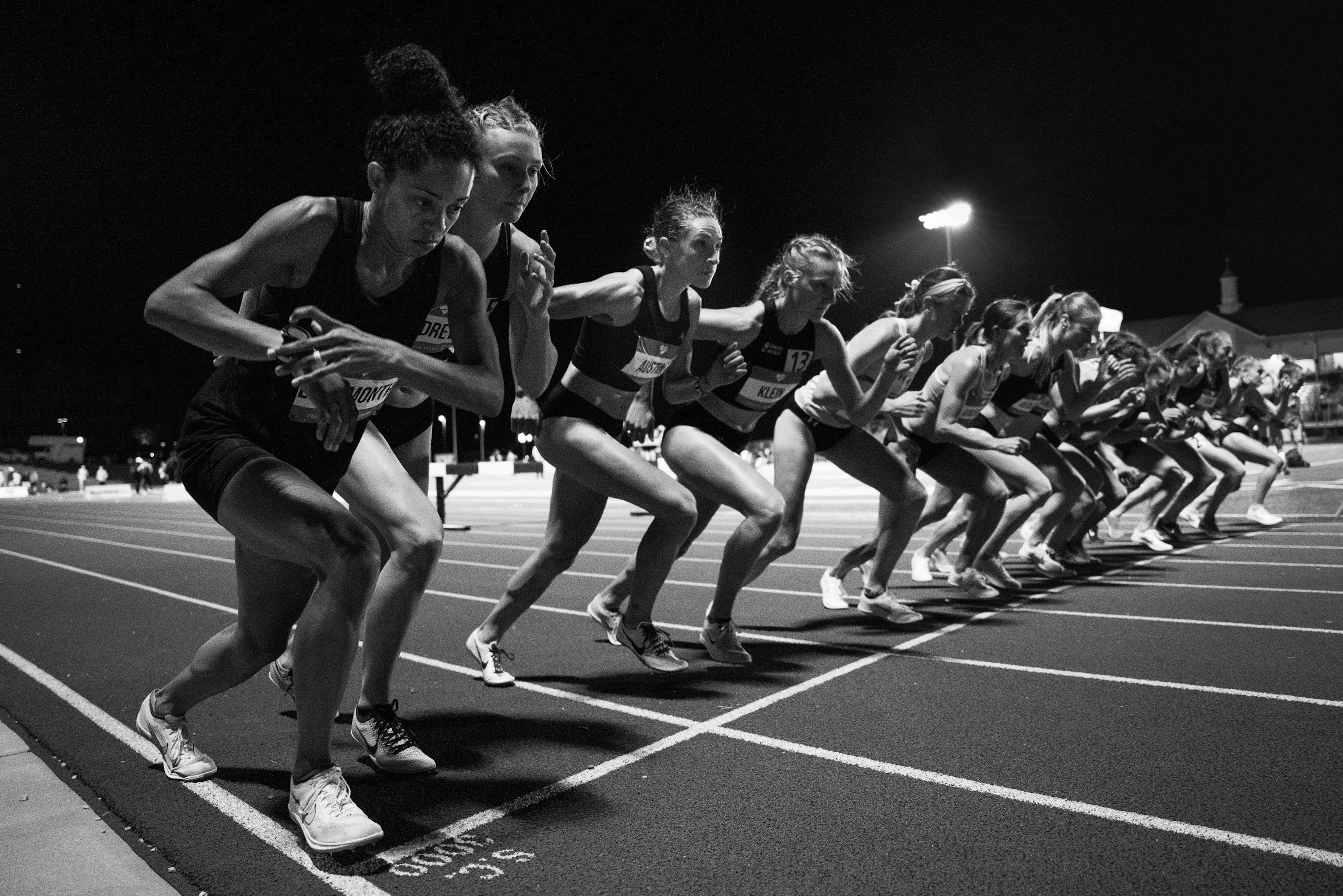
Caroline Austin
Outrunning
Binaries

Words by Micah Ling
Photography by Aisha McAdams
For as long as she can remember, Caroline Austin (she/them) has felt “in the middle.” Not decidedly on one side or the other, but a bit of a mix. Her father is Black and her mother is white. She’s a sprinter and a distance runner – able to train for two very different races at the same time. She identifies as gender-fluid and queer. And, she likes it in the middle. She’s learned that she doesn’t have to stay in one lane to fit in.
“Growing up I wasn’t [just] a sprinter, but I wasn’t [just] a middle-distance runner either. I was kind of in between, which is the story of my life. I’m the in-betweener. I’ve always occupied this space of the other – the middle of things.”
Caroline grew up in Chehalis, Washington – an old logging and railroad town of about 7,000 people. “I’ve always known that I was a little bit different, I just haven’t always known exactly what that means.” Caroline’s realizations, about where she fit in, came in fits and starts. “My whole life has felt a little bit fluid – like things come together where and when they need to.”

When she thinks about self and identity, and where she fits in, it feels more like a long run. Less about huge markers and more about the process. “I like to use my long runs as my decompression time – that’s my therapy – anything that’s been going on that needs to be hashed out mentally, by the time I finish that run, I just need to be done with it.”
Pretty much from the start, Caroline loved to run, and was good at it. She started running as a kid because she had so much energy. “I had problems focusing and staying on task, so my parents signed me up for a lot of different sports. Also my mom was a runner growing up, but it was never something that she got to fully explore – it just wasn’t a thing that a lot of women did when she was growing up. So they put me in everything to see what I liked.”
In addition to being in a small town in Washington, she also had a unique family situation. When she was nine-years-old, their family adopted three refugee kids from Sudan, and then later, two more.
“If my siblings hadn’t joined the family, I definitely would have been a very different person. It forced me to get out of my comfort zone, and be less self-centered – really think about other people’s needs. Before my siblings joined my family, I was very much in the headspace of ‘the world revolves around me.’ I was very selfish. In that way I’m very grateful for my siblings. I don’t even want to know who I’d be without them.”
Then, when Caroline was in fifth grade, their parents split up. Caroline considered their dad, who had been a stay-at-home parent, to be a best friend. “I didn’t understand why my best friend was no longer going to be living with me. I couldn’t wrap my head around that. So I definitely got into a lot of trouble at school that year.”
Still, Caroline doesn’t think negatively about their childhood at all. “I got to help [my siblings] adjust to a completely different world and society, and learn a new language, so I didn’t really have time to dwell on my own little things going on. Plus, until that point I had only grown up with a brother, so I was just happy to have sisters.”

Caroline and their siblings were always playing sports growing up, but she stood out as the most physical – she was doing even more than everyone else. Today, Caroline’s siblings live all over the country and have large families of their own, so they don’t all get to see each other very often, but they’re all part of their virtual cheer squad.
It was in college at Washington State University where Caroline really fell in love with the steeplechase. It seemed to fit their personality – a race that demands so much mentally and physically, and where so many things can happen. She had learned from an early age to adapt, go with the flow, and problem solve. In a lot of ways, that all served them well in racing steeplechase. Jumping over the barriers and maneuvering through the water pit and other racers, is a lot like life. Just when you think you’ve got the hang of it, you can miss a step and fall in the water. And then you’ve got to get up.
After college, Caroline moved to Seattle and got a job at Fleet Feet as a fit specialist. She also started coaching running, and learned more about running in the role of a teacher than she had ever known before. “It was a really important time for me as a post collegiate, both in coaching at Seattle University and re-learning what running can be.” In Seattle it seemed like the norm was longer distance running. Practically everyone she met was training for a marathon.
“I met a friend on a group run. He and I became really close and we have birthdays very close together, and so he talked me into running a marathon. He said, ‘we’re only 26 once, and we can only run 26-miles on our 26th birthday once.’”
So they did it. The Foot Traffic Flat Marathon in Portland, Oregon. And Caroline ran well. She qualified for Boston. So she ran Boston – the 2018 race with horrible weather, where tons of people dropped out. But she finished – about 13-minutes behind Des Linden, who won. Caroline came in 23rd, and despite the conditions, ran a faster time than at her first marathon. She was finding a stride – feeling like theirself. And she hadn’t even truly trained for a marathon yet.

In 2019, Caroline ran the Houston Marathon in a time of 2:44:55 and qualified for the Olympic Trials by five seconds. All the while, she had never stopped training for steeplechase, which she also qualified for the Trials in.
“They’re definitely very different [events]. The cool thing about it that I’ve unexpectedly learned is that the mental part of it is a really easy transfer.” For Caroline, it’s the same headspace, “except, in a marathon you don’t have to jump over anything.”
In terms of fitness, Caroline finds that it takes a while for the body to transition from marathon mode to steeplechase mode, just in terms of finding the speed again. But she likes the process – she likes pushing their body and seeing what it can do. And she really likes that no one else out there is doing such radically different events.
“I like being part of this really talented, really focused world of elite runners, but at the same time I don’t love a lot of the things that come with being an elite, because I don’t love the vibe of elitism and what that can do [to a person]. I don’t know that I would do very well, from a mental health standpoint, if I was one of the fastest people out there.” Being at the very top of the sport comes with a lot of stress – and a lot of expectation.

“I’m really glad to see more Black athletes out there – growing up we’re put in speed and power sports but not so much endurance sports. Representation is a real thing, that I didn’t give much credit to before. That’s really something I noticed being at the Olympic (marathon) Trials.” People – strangers – have reached out to Caroline through social media congratulating them and telling them how significant it is that she was one of so few non-white, American born women in the race. “It’s really crazy to think that there are 400 women at the start-line of this race, and I’m one of very few people who look like me.”
Caroline is fascinated by all aspects of running, and has experienced how important both the physical and mental sides to it are. Because of that, she’s become a successful coach for middle and high school runners. Their overall philosophy centers on the mind and the body, but she also wants to help kids learn how to be the strongest and happiest versions of themselves. “I want to teach them about the sport, but mainly just let them have fun. I try to remind them, at all ages, that this is something you can do for the rest of your life, but you have to love it. If you don’t love it, it’s not going to serve you well.” Caroline is grateful to have found the things she loves – running long distances, running short distances, jumping over obstacles, and being comfortable in the in between.